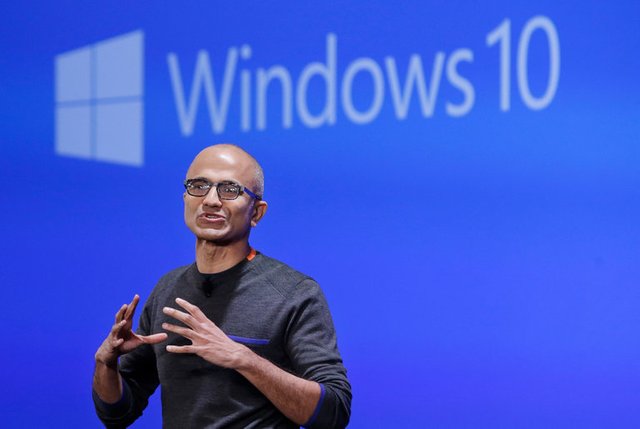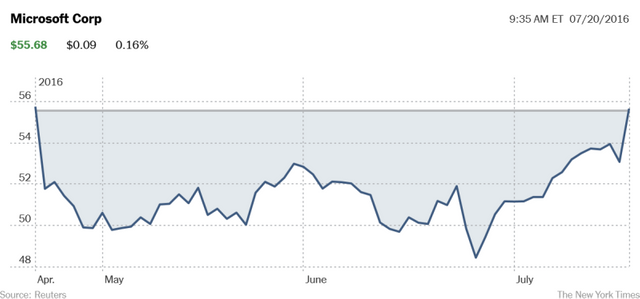
SEATTLE — Microsoft is best known for software products like Windows and Office. If you bought a PC, more often than not it came with Windows, and chances are you bought a copy of Office to go with it.But the personal computers that Microsoft makes a lot of software for aren’t selling the way they once did. And the company’s entry into the smartphone business — which has been eating into PC sales for several years — was a disaster.It’s a good thing Microsoft is determined not to miss the boat on cloud computing, a current trend that connects people over the internet to software hosted in big data centers.On Tuesday, in its quarterly earnings results, Microsoft offered strong signs that its cloud business was growing quickly. Revenue from Azure, a business Microsoft started to compete in cloud computing with Amazon, the market leader, rose more than 100 percent in the quarter.Revenue from Office 365, a subscription version of the old Office software, rose 54 percent from commercial customers and 19 percent from consumers. “I think they’ve done extraordinarily well,” said Merv Adrian, an analyst at the technology research firm Gartner. “There’s nobody else who is arguably the challenger to Amazon that Microsoft is.”Microsoft’s chief executive, Satya Nadella, has made cloud computing a priority for the company since becoming chief executive two years ago. Many believed it was a move that Microsoft had long needed to make but was held back by the reluctance of its previous boss, Steven A. Ballmer.There is risk in this transition. The profit margins from renting software in the cloud are not as high as selling a license to customers, and Microsoft investors have always counted on the company to generate exceptional profits. But the cloud business model tends to be more stable — a trade-off for slimmer margins.After Microsoft’s misadventures in the smartphone market, it is a necessary trade-off. Last week, the company said it would fail to meet a goal of getting its Windows 10 operating system running on one billion devices before June 2018, largely because of its retrenchment in the mobile phone business.Microsoft bought Nokia’s mobile handset business in 2014 for $9.4 billion, with the goal of making Windows relevant in smartphones, a market dominated by Google’s Android software and Apple’s iPhones.

Now the company has laid off most of the thousands of people who joined Microsoft through the deal, written off the value of nearly all of the acquisition and whittled back the number of smartphones it sells. On Tuesday, Microsoft said that its phone revenue had declined 71 percent from a year ago.For years, people have put off purchases of new machines or avoided them entirely in favor of smartphones and tablets. Last week, IDC, the technology research firm, said worldwide PC shipments fell 4.5 percent in the most recent quarter compared with a year earlier.Still, Microsoft sometimes manages to outperform the PC market, as it did this quarter, often through sales of the operating systems for higher-end machines. The company’s Windows revenue from PCs sold for the professional market rose 2 percent in the quarter. Windows revenue from the nonprofessional market rose 27 percent, though that was in comparison with an unusually weak quarter last year.For the quarter ended June 30, Microsoft reported net income of $3.12 billion, or 39 cents a share, compared with a loss of $3.2 billion, or 40 cents a share, during the same period a year earlier.The company’s shares jumped about 4 percent in after-hours trading following the release of its results.The loss a year ago included $8.4 billion in charges related to a write-down in the value of the smartphone business it acquired from Nokia, along with expenses from layoffs in that group. The pain continued in its most recent quarter with further write-downs and restructuring charges related to its phone business totaling $1.1 billion.Revenue fell to $20.61 billion, from $22.18 billion a year ago. The decline was partly the result of a $2 billion deferral of revenue related to Windows 10, its latest operating system. Accounting rules require Microsoft to recognize revenue from the software to be recognized in pieces over time.Without the deferral, Microsoft’s revenue rose 2 percent from a year earlier to $22.64 billion, better than the $22.14 billion average estimate of analysts surveyed by Thomson Reuters. And excluding the deferral and phone business charges, it earned 69 cents a share, better than the 58 cents a share average estimate of analysts.About 6 cents a share of the upside in its earnings was the result of a lower-than-expected tax rate, Amy Hood, Microsoft’s chief financial officer, said in a phone interview.“This is a nice strong quarter,” said Colin Gillis, an analyst at BGC Financial. “It’s still a company in a pivot with some declining legacy businesses.”
article possibly stolen from nytimes http://www.nytimes.com/2016/07/20/technology/microsoft-earnings-are-up-cushioned-by-its-cloud-business.html
Downvoting a post can decrease pending rewards and make it less visible. Common reasons:
Submit